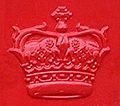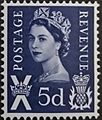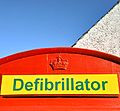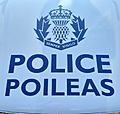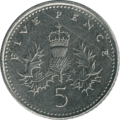Crown of Scotland facts for kids
Quick facts for kids Crown of Scotland |
|
|---|---|

Crown of Scotland
|
|
| Details | |
| Country | Scotland |
| Made | 1540 (current version) |
| Owner | Queen Elizabeth II as Monarch of the United Kingdom |
| Weight | 1.64 kg (3.6 lb) |
| Arches | 2 |
| Material | Scottish gold |
| Predecessors | Pre-1540 example remade to current version. |
The Crown of Scotland is a very special crown. It was used when the kings and queens of Scotland were crowned. This crown is part of the Honours of Scotland, which are the oldest royal jewels in the British Isles. The crown you see today was made in 1540 for King James V. But there was an older version of it even before that, shown in a painting from 1503.
Contents
How Was the Crown Made?
In 1540, King James V asked a royal goldsmith named John Mosman to remake the Crown of Scotland. The old crown was quite fragile and had been fixed many times. It was even missing a decorative part called a fleur-de-lis.
Mosman took the old crown apart. He removed all its precious stones and pearls. Then, he melted down the gold from the old crown. He added more gold, about 41 ounces, which came from Crawford Moor in Lanarkshire.
The crown is made of solid gold. It has a base with four fleur-de-lis designs. These are shaped like lilies. Between them are four designs that look like strawberry leaves. Four arches rise from the base. They are decorated with gold and red oak leaves.
At the top, where the arches meet, there is a golden globe. This globe is painted blue with gold stars. On top of the globe is a large cross. This cross is decorated with gold, black enamel, and pearls. The crown sparkles with 22 gemstones, like garnets and amethysts. It also has 20 other precious stones and 68 Scottish freshwater pearls.
King James V also ordered a special cap to go inside the crown. It was made of purple fabric and soft ermine fur. Later, King James VII changed the cap's color to red. The cap has been replaced several times over the years. The one you see today was made in 1993. The finished crown is quite heavy, weighing about 1.64 kilograms (or 3.6 pounds).
How Was the Crown Used?
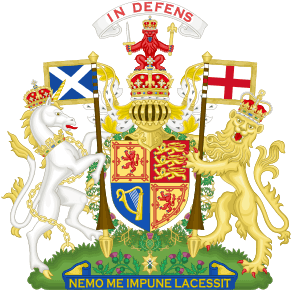
The Crown of Scotland was first worn by King James V in 1540. He wore it at the coronation of his second wife, Mary of Guise, at Holyrood Abbey. After that, it was used to crown child monarchs. These included Mary I in 1543 and James VI in 1567.
In 1603, King James VI of Scotland also became King of England and Ireland. This was called the Union of the Crowns. The royal family then moved from Edinburgh to London. Even though the monarch wasn't always in Scotland, the Crown of Scotland was still important. It was carried to meetings of the Parliament of Scotland. This showed that the king or queen was still present and approved new laws.
The crown was used for the Scottish coronations of King Charles I in 1633 and King Charles II in 1651. However, no Scottish monarch after them was crowned with this specific crown.
During the English Civil War, Oliver Cromwell wanted to destroy all royal jewels. He had already destroyed the English ones. But the Scottish Crown Jewels were secretly hidden away. They were buried until the monarchy was brought back in 1660.
After the Act of Union in 1707, Scotland and England became one country: Great Britain. The Crown of Scotland no longer had a role in the new Parliament in London. So, the Honours were locked away in Edinburgh Castle. They were almost forgotten until 1818. That's when a group of people, including Sir Walter Scott, found them.
Since 1819, the Honours have been on display in the Crown Room of Edinburgh Castle. They are only taken out for very special state events. The first time this happened was in 1822. King George IV visited Scotland, and the crown was presented to him. This was the first visit by a reigning monarch since 1651.
On June 24, 1953, after her coronation in London, Queen Elizabeth II visited Edinburgh. The Crown of Scotland was carried before her in a procession. It went from Holyroodhouse to St Giles' Cathedral. There, the Honours of Scotland, including the crown, were presented to the Queen during a special service.
More recently, the crown has been part of the opening ceremonies of the Scottish Parliament. This includes the first opening in 1999. It was also present when the new Scottish Parliament Building opened in 2004. On these occasions, the crown is carried by the Duke of Hamilton. He is the traditional bearer of the Crown of Scotland. It always goes just before the Queen in the procession.
Where Else Does the Crown Appear?
The Crown of Scotland is a very important symbol. You can see it in the Royal coat of arms of the UK used in Scotland. It also appears in the Scottish versions of the Royal Cypher (the monarch's initials). The crown is also part of the arms used by the Scotland Office. It was even on the arms of the former Scottish Executive.
Stylized versions of the crown appear on many badges. These include the badges of the Royal Regiment of Scotland, The Royal British Legion Scotland, the Scottish Ambulance Service, and Police Scotland. It's also part of the logos for the Crown Office and Procurator Fiscal Service, RCAHMS, and General Register Office for Scotland.
You can also see a version of the crown on Royal Mail buildings and vehicles in Scotland. It's on Scottish pillar, lamp, and wall boxes. There's even a metal plate with the Crown of Scotland inside red K6 red telephone boxes in Scotland.
From 1927 to 1975, the arms of Kincardineshire County Council featured the crown. It was shown with the sword and sceptre above Dunnottar Castle. This was to remember that the Honours of Scotland were hidden there in the 17th century.
The Crown of Scotland also appears on flags used at sea. This includes the Blue Ensign of ships belonging to Marine Scotland. It's also on the flags of some Royal yacht clubs in Scotland.
From 1968 to 2008, the back of the Five pence coin had the Royal Badge of Scotland. This was a thistle with the Crown of Scotland on top.
The crown, as part of the Royal Badge of Scotland, also appeared on some Royal Mail stamps from 1958 to 1970.
In 2003, a new crown was made for the Lord Lyon. This crown was designed to look like the Crown of Scotland. It has arches that can be removed. This is done during coronations to show respect to the monarch.
Gallery
-
A representation of the Crown of Scotland found on cast iron Royal Mail pillar boxes, lamp boxes and wall boxes in Scotland
-
Post mounted Royal Mail lamp box in Killearn, Stirlingshire, showing the Crown of Scotland in place of the St Edward's Crown/EIIR cypher
-
Elizabeth II era Royal Mail wall box in Edinburgh, showing the Crown of Scotland
-
Carved version of the Honours of Scotland which denotes the Royal Pew at the Kirk of the Canongate, Edinburgh.
-
The Royal Regiment of Scotland includes the Crown of Scotland in its badge, shown here on the blanket of the regiment's Shetland Pony mascot.
-
Royal coat of arms of the United Kingdom used in Scotland by the British Government, (Scotland Office), rendered in full colour. The Crown of Scotland surmounts the escutcheon and both supporters.
-
Marine Scotland's ensign; A blue ensign defaced by an anchor and chain, accompanied by silver letters SF (Scottish Fisheries), within a thistle wreath and surmounted by the Crown of Scotland.
-
Crest of the (historic) Royal Arms of Scotland and of the Royal Arms of the UK used in Scotland; the lion of the King of Scots atop the Crown of Scotland, bearing the Honours of Scotland. Motto: IN DEFENS
-
The reverse of a Five pence (British coin) showing the Crown of Scotland as a component of the Royal Badge of Scotland: A Thistle Royally Crowned.
Images for kids
-
The Crown of Scotland at the opening of the Scottish Parliament in July 2011, being held by the Hereditary Keeper, the Duke of Hamilton.


